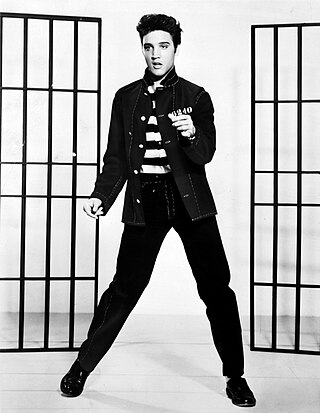
Elvis Aaron Presley, also known mononymously as Elvis, was an American singer and actor. Known as the "King of Rock and Roll", he is regarded as one of the most significant cultural figures of the 20th century. Presley's energized interpretations of songs and sexually provocative performance style, combined with a singularly potent mix of influences across color lines during a transformative era in race relations, brought both great success and initial controversy.

"Heartbreak Hotel" is a song recorded by American singer Elvis Presley. It was released as a single on January 27, 1956, Presley's first on his new record label RCA Victor. It was written by Mae Boren Axton and Tommy Durden, with credit being given also to Presley. A newspaper article about the suicide of a lonely man who jumped from a hotel window inspired the song. Axton presented the song to Presley in November 1955 at a country music convention in Nashville. Presley recorded it on January 10, 1956, in a session with his band, the Blue Moon Boys, the guitarist Chet Atkins and the pianist Floyd Cramer. "Heartbreak Hotel" comprises an eight-bar blues progression, with heavy reverberation throughout the track, to imitate the character of Presley's Sun recordings.

Elvis Presley is the debut studio album by American rock and roll singer Elvis Presley. It was released by RCA Victor, on March 23, 1956,. The recording sessions took place on January 10 and January 11 at the RCA Victor Studios in Nashville, Tennessee, and on January 30 and January 31 at the RCA Victor studios in New York. Additional material originated from sessions at Sun Studio in Memphis, Tennessee, on July 5, August 19 and September 10, 1954, and on July 11, 1955.

Singer Presents ... Elvis, commonly referred to as the '68 Comeback Special, is an Elvis Presley concert special that aired on NBC on December 3, 1968. It marked Presley's return to live performance after a seven-year period during which he focused on his film appearances.

Aloha from Hawaii via Satellite is a concert starring Elvis Presley that took place at the Honolulu International Center and was broadcast live via satellite to audiences in Asia and Oceania on January 14, 1973. The show was presented with a delay in Europe. In the United States, to avoid a programming conflict with Super Bowl VII and Elvis on Tour which was playing in cinemas at the time, NBC opted to air a ninety-minute television special of the concert on April 4.

"Are You Lonesome Tonight?" is a song written by Roy Turk and Lou Handman in 1926. It was recorded several times in 1927—first by Charles Hart, with successful versions by Vaughn De Leath, Henry Burr, and the duet of Jerry Macy and John Ryan. In 1950, the Blue Barron Orchestra version reached the top twenty on the Billboard's Pop Singles chart.

From Elvis in Memphis is the ninth studio album by American rock and roll singer Elvis Presley. It was released by RCA Records on June 2, 1969. It was recorded at American Sound Studio in Memphis in January and February 1969 under the direction of producer Chips Moman and backed by its house band, informally known as the Memphis Boys. Following the success of Presley's TV special Elvis and its soundtrack, the album marked Presley's return to non-soundtrack albums after the completion of his film contract with Metro-Goldwyn-Mayer.

Elvis is the second studio album by American rock and roll singer Elvis Presley, released by RCA Victor on October 19, 1956 in mono. Recording sessions took place on September 1, September 2, and September 3 at Radio Recorders in Hollywood, with one track left over from the sessions for Presley's debut album at the RCA Victor recording studios on January 30 in New York. It spent four weeks at #1 on the Billboard Top Pop Albums chart that year, making Presley the first recording artist to have both albums go straight to number one in the same year. It would go on to spend 5 weeks at #1 in total. It was certified Gold on February 17, 1960, and Platinum on August 10, 2011, by the Recording Industry Association of America.
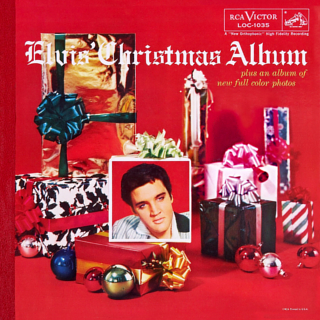
Elvis' Christmas Album is the third studio album and first Christmas album by American singer and musician Elvis Presley on RCA Victor, LOC -1035, a deluxe limited edition, released October 15, 1957, and recorded at Radio Recorders in Hollywood. It has been reissued in numerous different formats since its first release. It spent four weeks at No. 1 on the Billboard Top Pop Albums chart, and was the first of two Christmas-themed albums Presley would record, the other being Elvis Sings the Wonderful World of Christmas, released in 1971. The publication Music Vendor listed Elvis' Christmas Album on their singles charts for two weeks in December 1957 – January 1958, with a peak position of No. 49.

Elvis Is Back! is the fourth studio album by American singer Elvis Presley, released on April 8, 1960 by RCA Victor. It was Presley's first album of new material since 1958's King Creole soundtrack, as well as his first to be recorded and released in stereophonic sound. The album marked Presley's return to music after his discharge from the U.S. Army.

His Hand in Mine is the fifth studio album by American singer and musician Elvis Presley, released on November 23, 1960 by RCA Victor in mono and stereo, catalog number LPM/LSP 2328. It was the first of three gospel albums that Presley would issue during his lifetime. Recording sessions took place on October 30 and 31, 1960, at RCA Studio B in Nashville, Tennessee. It peaked at #13 on the Top Pop Albums chart. It was certified Gold on April 9, 1969 and Platinum on March 27, 1992 by the Recording Industry Association of America.
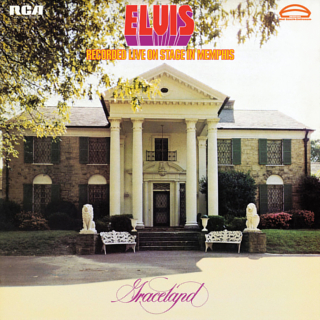
Elvis Recorded Live on Stage in Memphis is a live album by American singer and musician Elvis Presley, released by RCA Records in July 1974. It was recorded on March 20 of the same year at the Mid-South Coliseum in Memphis, Tennessee, Presley's hometown. The cover features a photograph of Presley's home, Graceland.

From Nashville to Memphis: The Essential '60s Masters is a five-disc box set compilation of studio master recordings by American singer and musician Elvis Presley during the decade of the 1960s; it was released in 1993 on RCA Records, catalogue number 66160-2. In its initial long-box release, it included a set of collectable stamps duplicating the record jackets of every Presley LP on RCA Victor, and those of the singles pertinent to this box set. The set also includes a booklet with an extensive session list and discography, as well as a lengthy essay by Peter Guralnick. It was certified Gold by the RIAA on November 30, 1993, and Platinum on January 6, 2004. This set followed an exhaustive box set of Presley's 1950s output and was followed by a more selective box set of his work in the 1970s.

Amazing Grace: His Greatest Sacred Performances is a two-disc compilation of studio master recordings by Elvis Presley, released in 1994 on RCA Records and certified double platinum by the RIAA on July 15, 1999. The release also includes a booklet with session details and an essay by Charles Wolfe.

Peace in the Valley is an EP by American singer and musician Elvis Presley, released in April 1957 on RCA Victor Records in mono with catalogue number EPA 4054. It reached number three on the short-lived Billboard EP chart, number three on the album chart and number 39 on the singles chart.
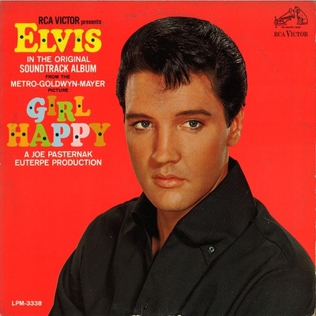
Girl Happy is the tenth soundtrack album by American singer and musician Elvis Presley, released on RCA Victor Records in mono and stereo, LPM/LSP 3338, in March 1965 – the March 1 date is disputed. It is the soundtrack to the 1965 film of the same name starring Presley. Recording sessions took place at Radio Recorders in Hollywood, California, on June 10, 11, 12, and vocal overdubs by Presley on June 15, 1964. It peaked at number eight on the Top LP's chart. It was certified Gold on July 15, 1999 by the Recording Industry Association of America.

"Santa Claus Is Back in Town" is a Christmas song written in 1957 by Jerry Leiber and Mike Stoller, and first recorded that year by Elvis Presley as the opening track on Elvis' Christmas Album, the best-selling Christmas/holiday album of all time in the United States. The song has become a rock and roll Christmas standard.

"We're Gonna Move" is a song by Elvis Presley. The song is credited to Elvis Presley and Vera Matson, the wife of Ken Darby, the principal writer, published by Elvis Presley Music. The song was featured in the 20th Century Fox movie Love Me Tender and was released as an RCA Victor EP in 1956.

The singles discography of Elvis Presley began in 1954 with the release of his first commercial single, "That's All Right". Following his regional success with Sun Records, Presley was signed to RCA Victor on November 20, 1955. Presley's first single with RCA, "Heartbreak Hotel", was a worldwide hit, reaching the No. 1 position in four countries and the top 10 in many other countries. Other hit singles from the 1950s include "Don't Be Cruel", "Hound Dog", "Love Me Tender", "Too Much", "All Shook Up", "(Let Me Be Your) Teddy Bear", "Jailhouse Rock", "Don't", "Hard Headed Woman" and "A Big Hunk o' Love". On March 24, 1958, Presley entered the United States Army at Memphis, Tennessee, and was stationed in Germany. He left active duty on March 5, 1960.
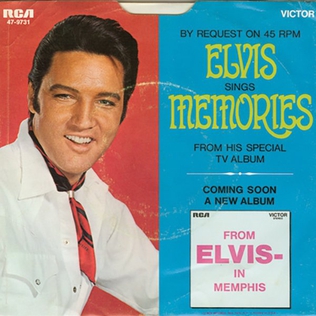
"Memories" is a 1968 song originally recorded by Elvis Presley.






















